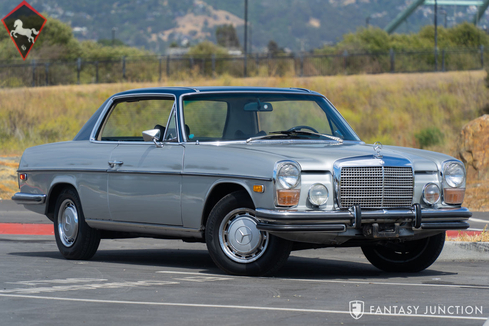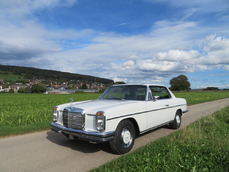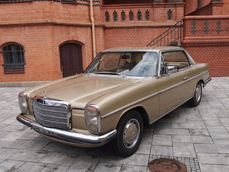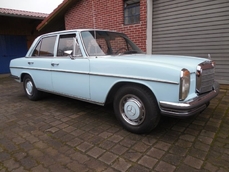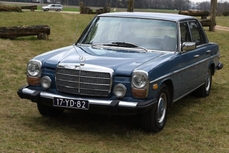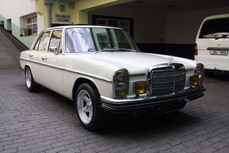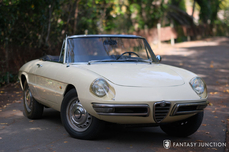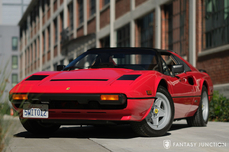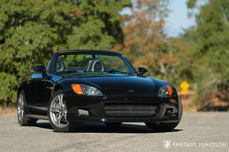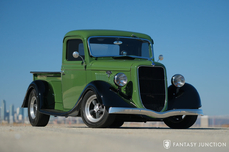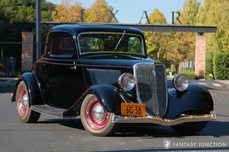Mercedes-Benz 280 w114 2.7L straight 6-cylinder 1973
General description :
1973 Mercedes Benz 280 Coupe
Chassis No. – 114 073 12 001412
Engine No. – 110 921 12 005280
Exterior Color – Astral Silver with Deep Blue roof
Interior Color – Blue Leather
Engine – 2.8 Liter in-line 6 cylinder
Transmission – 4 speed automatic
Mileage – 96,463 miles
Highlights of this Mercedes-Benz
-Factory AC and Electric Sunroof
-Ordered and delivered new to Northern California
-Documented with original owner’s service record book and recorded miles
-Recent refurbishment with cold AC, new leather interior, and new paint
General History
Mercedes-Benz has long been associated with the finest in engineering and vehicle manufacturing. Collectors and enthusiasts continually select these cars for performance, design, and exceptional engineering. Decades of racing and luxury refinement from the 50s and 60s vaulted Mercedes-Benz into the growing US market as they imported exciting models to both new and dedicated customers. In 1968, the W114 and W115 models arrived as “new generation” models. In addition to being the first post-war Mercedes-Benz production car with a newly engineered chassis, the beautiful and elegant body designs of Paul Bracq were fresh and yet classically composed. Among the finest of this series of coupes, the 280C is considered one of the best-looking cars of this era. Today, contemporary collectors are surprised to find that these were built in such limited numbers. With so many examples having lived up to their legendary service accruing ample miles, it is all the more satisfying to find an original example that has been recently refurbished and prepared for enjoyable use.
History of This Car
This 280C is documented by a copy of the original data card which has been translated by Mercedes-Benz Classic Center indicating the car was finished at the factory in Astral Silver with a Deep Blue roof and optioned with the following features:
401 – Single Seats
410 – Electric Slide Roof
423 – Power Steering
491 – USA Version
513 – Becker Radio Europa
524 – Paintcoat Preservation
570 – Front Armrest
580 – Behr Air Conditioner
593 – Heat Insolating Glass
669 – 10 Liters on Fuel
The car was delivered to North America and sold new by Steve Swaab European Motors, Ltd., San Francisco, CA. The original owner retained the car in Hillsborough, CA with the first of many recorded services inked and stamped in the original booklet accompanied by the VIN-punched service manual and owner’s manual. A sample of entries include March 2, 1973, with 843 miles by Autohaus Brugger, Redwood City, CA, with documented mileage accrued to 28,935 in August 1975, 60,839 miles in June 1978, and 83,901 miles in December 1982. The second owner, a resident of San Francisco, CA retained the car largely under long-term indoor storage for many years until selling it to the third and current owner, also a San Francisco resident. The current owner, excited by the rarity of options and originality, purchased the car in 2020, electing to refurbish it during his past two years of ownership.
Under current ownership, in August 2020 (95,001 miles) the brakes were redone including new calipers and rebuilt calipers front and rear, new pads, new hoses and fluid flush. The heater valve and seals were replaced, a new tie rod assembly, new steering coupler, center drag link and steering shock were installed. A new shift indicator was installed along with a new transmission modulator, a new water pump and belts, new spark plugs, carburetor kit, and the radiator was removed, serviced and reinstalled with new hoses. The Air Conditioning for the car was completely rebuilt and upgraded to modern R134A with new hoses and lines changed out during the conversion. The sunroof was lubricated and checked for smooth operation. For the interior, the front and rear seats were recovered in correct blue leather and a set of correct carpets were also installed. A new speaker grille was fabricated by Madera Concepts and a new headliner installed. The car was professionally repainted in August 2021. In February 2021, a set of Hancook 195/75 R-14 tires were installed, and a four-wheel alignment performed. In November 2021, a new power steering pump and fuel pump were installed, a the carburetor accelerator pump replaced, and a new dome light installed.
Current Condition
Today this 280C offers a very satisfying overall cosmetic presentation ready for enjoyable driving. The highly desirable coupe body lines are in excellent condition and the recently applied silver paint displays a fine luster with a nice combination of original trim and refinished trim and beautifully applied dark blue roof color. The doors shut with an excellent snap and firm closure, while the hood and trunk show very good panel gaps in keeping with original specifications. All chrome appears in good to very good condition, showing some light marks and a few imperfections under closer examination, but otherwise in keeping with the integrity of three owners and known mileage. Lenses, lighting, and glass are in very good condition including the windshield which shows only mild road chips from general use. The car wears a set of recently purchased Hancook tires mounted on steel wheels. The wheels are dressed with full wheel covers in generally good condition with curb rash visible on two of the wheel covers.
The interior is handsomely finished using correct, high-quality leather in the correct factory color. Finishes have been carefully combined with the original blue dashboard and instruments. The various switches, knobs, and controls retain clean cosmetic presentation overall including an original Becker radio as specified when new. The air conditioning vents and controls work smoothly, the AC blows cold, and the original gauges are in excellent condition with clear nomenclature and dials. The new and correct low pile carpeting is in excellent condition both front and rear. The steering wheel includes the correctly padded centerpiece, Mercedes-Benz logo, and a smooth chrome horn ring. The original wood dash is impressively preserved with excellent finishes and detailing. The dash pad is in excellent condition as well. The interior door panels and rear seating convey an authentic look and feel with good fit and smooth finish, adding to the authentic look and feel throughout the car. The trunk is properly finished in satin black both on the trunk floor and underside of the trunk lid.
Under the hood, the engine compartment and engine have been properly maintained and detailed with correct factory finishes and proper hardware. Clearly serviced by professionals who have paid close attention to correct Mercedes-Benz parts and service guidelines, the engine appears tidy overall, clean, and very well prepared. Though not detailed or polished for show, the components retain genuine finishes in keeping with a car that has been thoughtfully enjoyed and cared for by all three Northern California-based owners.
The car starts easily, delivering a very smooth idle and responsive acceleration. Driving manners are relaxed and spirited when called upon. The driving experience is airy and light, particularly due to the expansive glass and upright driving position. The elegant ease, superb ride engineering, and independent suspension are among the best offered for this era. Mechanically the car performs as one might expect, offering smooth power delivery and leisurely touring, excellent automatic shifting, and solid braking. Further pleasure can be enjoyed lowering all side windows and opening the electric sunroof for warm evening rides or enjoying cold AC on hot days with the windows up. The undercarriage and chassis components are dry and remarkably clean, representative of the California miles recorded on the car. There is no evidence of structural compromises to visible portions of the unibody.
A handsome and rare 280C, this Mercedes-Benz is a wonderful touring car offering durability, distinction, air conditioning, and electric sunroof in a very drivable package. Comfortable for four passengers with ample trunk space for outings, golf bags, or long-distance travel, this example offers enthusiasts a delightfully agile vehicle ready for leisurely enjoyment, casual car shows, or touring events.
Included with This Car
The car is accompanied by the original owner’s manual, original maintenance booklet with stamped and dated entries, 280C Engine/Chassis book, a set of aftermarket rubber floor mats, and a rubber trunk mat.
https://fantasyjunction.com/inventory/1973-mercedes-benz-280c-coupe/overview
1973 Mercedes-Benz 280 w114 2.7L straight 6-cylinder is listed sold on ClassicDigest in Emeryville by Fantasy Junction for Not priced.
Car Facts
Car type : Car Make : Mercedes-Benz Model : 280 w114 Model Version : 2.7L straight 6-cylinder Engine size : 2.7 Model Year : 1973 Location : Emeryville Vehicle Registration : Normal
Sold
Seller Information
Sold
People who viewed this Mercedes-Benz 280 w114 also viewed similar Mercedes-Benz listed at ClassicDigest
Other cars listed for sale by this dealer
About Mercedes-Benz
In the annals of automotive history, the journey of Mercedes-Benz is a tale that unfolds with the ingenuity of its founding pioneers. In the year 1886, Karl Benz crafted the Benz Patent Motorwagen, a creation that would go down in history as the world's inaugural automobile. Unbeknownst to him, this moment marked the genesis of what would evolve into the most illustrious premium car manufacturer globally. The financial underpinning of this pioneering venture, interestingly, was provided by Karl Benz's wife, Bertha Benz, demonstrating a remarkable partnership that would set the tone for Mercedes-Benz's legacy.A parallel narrative emerged not far away, as Daimler-Motoren-Gesellschaft, founded by Gottlieb Daimler and Wilhelm Maybach, entered the scene. In 1901, they unveiled their automobile under the now-famous moniker "Mercedes," meaning "godsend" in Spanish. This name was bestowed upon the car at the behest of Emil Jellinek's daughter, the distributor for Daimler-Motoren-Gesellschaft. The wheels of innovation were set in motion.
Fast forward to 1926, a pivotal year that witnessed the merger of Daimler with Benz & Cie., culminating in the birth of Daimler-Benz. The amalgamation saw the adoption of "Mercedes-Benz" as the distinguished trademark for their automobiles, fusing the legacies of two visionary entities into one.
Contrary to perceptions of conservatism, the trajectory of Daimler-Benz unfolds as a chronicle of industry firsts. From the introduction of the honeycomb radiator to the float carburetor, and the pioneering implementation of four-wheel brakes in 1924, Daimler-Benz consistently pushed the boundaries of automotive innovation. The diesel-powered Mercedes-Benz 260 D in 1936 marked the inception of diesel engines in passenger cars. The iconic Mercedes-Benz 300SL Gullwing made history as the first car with direct fuel injection, albeit the Gutbrod's tiny 2-stroke engine can claim precedence.
Safety innovations became a hallmark, with Béla Barényi's patented safety cell design in the "Ponton"-models in 1951, featuring front and rear crumple zones. The W116 450SEL 6.9 saw the introduction of the Anti-Lock Brake system (ABS), another pioneering safety feature. From the first production airbags and beyond, the legacy of "firsts" continued to be etched into the fabric of Daimler-Benz.
Over its centennial journey, Mercedes-Benz has not merely produced cars but has sculpted automotive icons. The SSKL, 710 SSK Trossi Roadster, 770K Grosser, 540K Spezial Roadster, 300SL Gullwing, w100 600 Pullman, w111 280SE 3.5 Flachkühler, w113 230SL Pagoda, w109 300 SEL 6.3, and w201 2.3-16 Cosworth stand testament to the brand's commitment to engineering excellence.
The roaring Silver Arrows, or "Silberpfeile," including the W 25, W 125, W154, W165, and W196, created a legacy of dominance on the racetrack. These machines were not merely cars; they were expressions of precision, speed, and an indomitable spirit that left their competitors in the dust.
As Mercedes-Benz marches into the future, it does so not just as an automaker but as a custodian of a legacy, a torchbearer of innovation, and a beacon of automotive excellence. The road ahead is sure to witness the continued fusion of cutting-edge technology, timeless design, and an unwavering commitment to setting new standards in the world of automobiles.
One luminary figure who left an indelible mark was Béla Barényi, often heralded as the "father of passive safety" for his pioneering work in safety engineering. His patented safety cell design, featuring front and rear crumple zones, became a hallmark of Mercedes-Benz's commitment to occupant safety, setting new standards that reverberated throughout the automotive world.
Moving through the chronicles, the collaborative genius of Wilhelm Maybach, alongside Gottlieb Daimler, laid the foundation for Daimler-Motoren-Gesellschaft. Their innovations not only birthed the first Mercedes but established a culture of relentless pursuit of technological excellence that remains integral to Mercedes-Benz's DNA.
In the post-merger era of 1926, Ferdinand Porsche emerged as a prominent figure within Mercedes-Benz. His work on the Mercedes-Benz S-Type, a supercharged race car, garnered acclaim and set the stage for a legacy that extended far beyond the marque. Porsche's impact would later extend to his eponymous company, but his influence at Mercedes-Benz during those formative years was pivotal.
As the 20th century progressed, the legendary Rudolf Uhlenhaut emerged as a key figure. Uhlenhaut, an accomplished engineer and the driving force behind the iconic Silver Arrows, played a crucial role in Mercedes-Benz's dominance in motorsports. His engineering prowess and attention to detail were instrumental in creating some of the most formidable racing cars of the era.
In the latter half of the century, figures like Bruno Sacco, the head of design at Mercedes-Benz from 1975 to 1999, left an indelible imprint on the brand's aesthetic identity. Sacco's design philosophy, characterized by clean lines and timeless elegance, shaped iconic models like the W126 S-Class and the W201 190E, solidifying Mercedes-Benz's reputation for luxury and sophistication.
The narrative would be incomplete without acknowledging the contributions of engineers like Hans Scherenberg, whose leadership in the 1970s ushered in a new era of technological innovation at Mercedes-Benz. Scherenberg's tenure saw the development of groundbreaking technologies, including the Anti-Lock Brake system (ABS) and the introduction of airbags in production cars.
